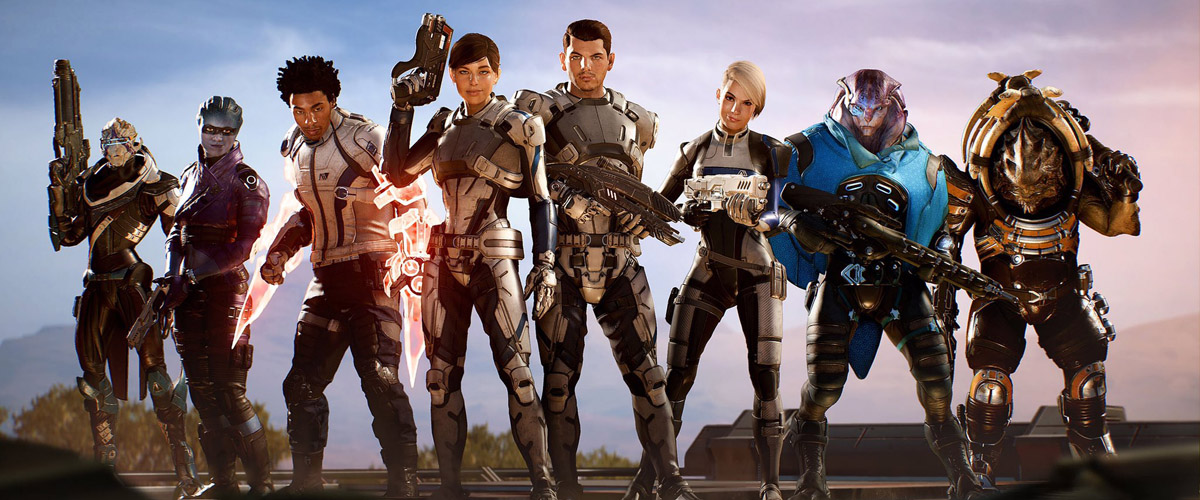Instead of recognizing this as a key problem, instead of rethinking the central mystery to make it active and immediate and compelling, the game’s designers make their second big mistake: In order to give the player something to do, they throw in a bunch of additional story, mostly unrelated, on top of the main mystery. And not just one story, either; the player is expected to pursue three separate primary threads through the course of Andromeda.
One — Solve the mystery of the Remnant, as described above. Explore the alien ruins, figure out how and why they were attacked and broken, reverse the damage, heal the sick planets. As noted, this is a fairly static investigation, repetitive and increasingly dull, because it’s clear the solution to the mystery is being held back artificially, waiting for you to jump through all the hoops.
Two — Some parts of the colonization project arrived ahead of you; and when everything went to hell, they fragmented into warring factions and split up, thereby creating a huge mess before you even begin playing. So, at the same time you’re poking around the Remnant sites, you also need to try to bring your divided people back together, through a combination of combat and diplomacy. This is almost entirely a separate story track from the Remnant mystery; the schism is initially caused by the failure of the colonization plan because the Remnant/Scourge problem means the target worlds are inhospitable, but after that, it plays out as mostly unrelated. Even the work to fix the Remnant sites and heal the broken worlds doesn’t feel connected, because that’s a terraforming effort whose results won’t be noticed for years, which means it has next to no impact on the social and political dynamic of the planetside settlements. Indeed, if you choose to fix the Remnant sites on a planet and begin the environmental repair before doing anything else, the game doesn’t even bother to rewrite the dialogue for the local characters to indicate they’ve noticed the small-but-positive changes.

Three — On top of this, you also have to deal with the kett. They’re from somewhere else, and have come to this part of the galaxy to pillage and dominate, which means their story is, also, unconnected to the Remnant mystery. The kett leader is, like you, fascinated with the Remnant sites and technology, and is working to understand and operate them, in competition with your effort, for his own reasons. But that’s a superficial overlap; the kett come from another place and have their own thing going on, which makes this feel like another mostly unrelated narrative track. The designers do basically set aside the first two stories and focus on this third one for the game’s conclusion, which makes the climax much sharper and more satisfying than everything leading up to the finale; Andromeda really does build up a pretty good head of steam in its final hours. But the setup to get there is laborious, unfocused, and terribly disjointed.
And on top of that, there is a fourth major story arc, which unfolds as a series of memory flashbacks in one of the weirdest and most poorly considered gameplay mechanics in the whole Mass Effect franchise. As the Pathfinder leading the colonization effort, your brain is integrated with a supercomputer that enhances your abilities and gives you tips and suggestions throughout the game. The previous Pathfinder had the same connection, and used the computer to record several key memories from his life, which you get to unlock and view by reaching “trigger points” he’s left for you around the various environments. If you try to think about how this would work, exactly — the previous Pathfinder somehow knew you would be the successor and sprinkled these unlock points around the map to grant you access to these protected memories containing critical information, except he couldn’t have known any of that in advance, and anyway why would he want to parcel out this backstory in these tiny limited pieces instead of just, y’know, telling you what’s really going on — it makes your brain hurt. It’s an aggravating and completely phony video-game mechanic, transparently imposed on the overall arc for no purpose beyond adding even more story whose reveals are artificially dragged out as dramatically as possible.
And yet, as bad as all of that is, as much as it fragments the narrative experience and leaves the story of the game feeling jumbled and aimless, it’s still not the designers’ worst mistake.








